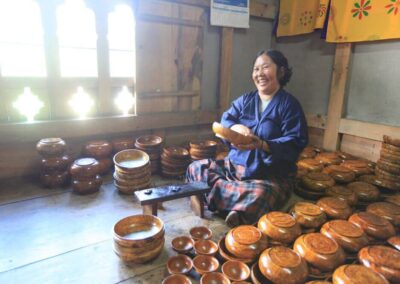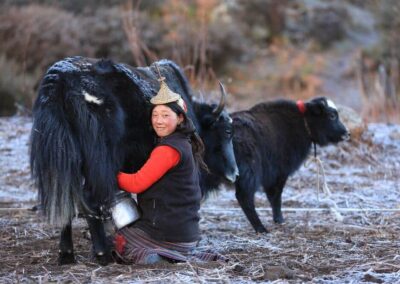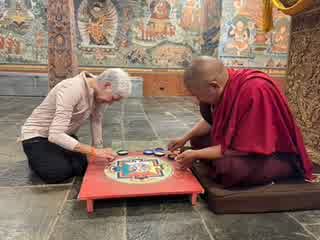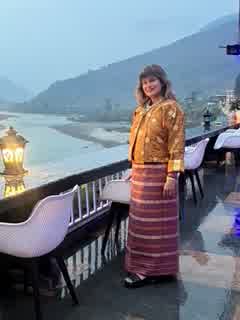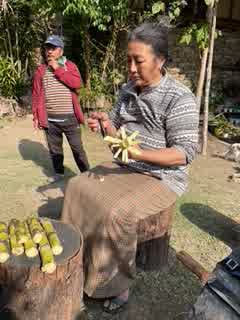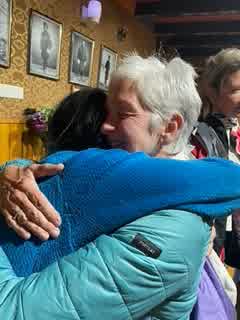May 4 — 12, 2024
Woman’s Heritage Walk, Bhutan
Cherishing the past to inform our best future
Bhutan is a magical country situated in the Eastern Himalayas. China is its Northern border, and India is to the South. Nepal and Bangladesh are near in proximity, but neither share a connecting border. They are locally known as ‘Druk Yul’ or “Land of the Thunder Dragon.” Bhutan is predominantly Buddhist and cares for its people, as it cares for the environment. In 1972, the 4th King of Bhutan, Jigme Singye Wangchuk, initiated the concept of Gross National Happiness with the aspiration of always keeping the best interest and wellness of the people of Bhutan at the center of governmental decisions. When visiting Bhutan, you will feel the kindness and compassion in the people you meet and the energy of the culture.
Interesting facts:
- Bhutan is a small and unique country located in the Eastern Himalayas, known for its rich culture and history.
- The Bhutanese Concept of Gross National Happiness: Bhutan measures its success not by GNH, but by Gross National Happiness (GNH), a concept that takes into account the well-being of its citizens and the preservation of its culture and environment.
- The traditional Bhutanese architecture: Bhutan’s traditional architecture is known for its intricate woodwork, intricate carvings, and paintings, and use of vibrant colors. The most notable architectural feature is the use of a unique architectural style called “dzong” which serves as both a fortress and a religious center.
- The Bhutanese traditional dress: The Bhutanese dress is called Gho for men and Kira for women. They are worn by Bhutanese citizens on all formal occasions, including in government offices, schools, and during religious ceremonies.
- Bhutan is a deeply religious country and Buddhism is the main religion. Bhutanese Buddhism is a unique blend of Mahayana Buddhism, with influences from Bon and tantra. The most famous religious sites include the Paro Taktsang, also known as Tiger’s Nest, a temple complex that clings to a cliff face and Punakha Dzong, a fortress-monastery.
- Bhutan is a land of festivals and they are an integral part of Bhutanese culture. These festivals are often colorful, lively, and showcase Bhutanese traditional customs, dances, and music. The most famous festivals are the Paro Tshechu, Punakha Dromchoe, and Jambay Lhakhang Drup.
- Archery is the national sport of Bhutan and is deeply ingrained in the Bhutanese culture. It is played on a field with large targets and is enjoyed by both men and women.
- Women in Bhutan enjoy many rights and opportunities and play an active role in the country’s social, economic, and political life.
- Women in Bhutan enjoy equal rights as men under the law. Bhutan’s constitution guarantees equal rights and opportunities to women in all aspects of life, including education, employment, and politics.
- Bhutanese women are actively involved in the workforce and have a high level of literacy. Women make up 47% of the country’s total labor force, according to the Bhutan Living Standards Survey.
- Women in Bhutan have traditionally held a significant role in agriculture. They are responsible for much of the country’s food production and are involved in all aspects of farming, from planting and harvesting to processing and selling.
- Bhutanese women are involved in politics at all levels of government. In 2013, Bhutan elected its first female minister, and in 2018, the country elected its first female parliamentarian.
Walks in and around:
- Punakha Valley
- Yebesa Temple and Village
- Pagalabtsa Pass (4,250m / 13,943ft)
- Trans Bhutan Trail
- Sertsho (Golden Lake)
- Yumtsho (Turquoise Lake)
- Divine Madman Temple
- Thimphu Valley
- Paro Valley
Historical Visits to:
- Punakha Dzong
- Khamsum Youlay Namgay Chorten
- Royal Botanical Garden
- Tiger’s Nest
- Tallest Sitting Buddha
- Textile Museum
- Dochula Pass
- Wolakha Nunnery
- Thimphu Farmer’s Market
Lectures by Experts on:
- Textiles
- Traditional Bhutanese Clothing
- Buddhism in Bhutan
- Meditation
- Lifestyle Wellness
- History of Bhutan
- Traditional Dance
- Women’s Leadership in Bhutan
- Gross National Happiness
- Zero Carbon Emission Environmental Vow
FAQS Bhutan
What is the fitness level required for the Walk.
Trekking in the mountains of Bhutan for 12 days, including passes of 13,000 feet, is a physically demanding and challenging adventure, and a good level of fitness is required. Here are some things to consider when determining if you are ready for this level of activity:
Cardiovascular fitness: Trekking at a high altitude for 12 days, including passes over 13,000 feet, requires a good level of cardiovascular fitness. This can be achieved by regular aerobic exercise such as brisk walking, cycling, or running, as well as by gradually increasing the altitude you are training.
Endurance: Being able to trek for several hours at a time and at high altitudes which requires a good level of endurance. Building up to this level of activity can be done by gradually increasing the duration and intensity of your training over time.
Strength: Trekking at a high altitude for 12 days requires good leg and core strength to help you maintain good posture and to carry your gear. Regular strength training exercises such as squats, lunges, and leg presses can help to build leg and core strength.
Flexibility: Trekking at high altitudes for long periods of time can be hard on the body, so flexibility is important to reduce the risk of injury. Stretching and yoga can help to improve your flexibility.
Training: It’s important to train for this level of activity by gradually increasing the distance and altitude of your training over time.
Acclimatization: As you will be trekking at a high altitude, you will need to allow yourself sufficient time to acclimatize before starting the trek.
Altitude sickness: Be aware of the symptoms of altitude sickness and know how to prevent and treat it.
It’s essential to consult with your doctor before attempting this level of activity, particularly if you have any health concerns or haven’t been physically active in a while. A medical clearance is required as part of the application.
It’s also important to note that, as you will be trekking at high altitudes, it’s essential to be well-prepared and to have a plan in case of an emergency, including knowing how to prevent and treat altitude sickness.
In addition to physical fitness, it is also important to have a positive attitude and good mental preparation for the trek. The trek will be challenging, and it’s important to be prepared for this, both physically and mentally. The 12 weeks of Wellness will help you to prepare. With proper preparation and training, you can increase your chances of having a successful and enjoyable trek in the mountains of Bhutan.
What will be the weather during our journey?
Bhutan has a diverse climate due to its varying elevation, with different regions experiencing different weather patterns. In general, October is considered the pre-winter season, and the weather can be cool and dry.
In the lower elevations, the temperature ranges from around 15-20 degrees Celsius (59-68 degrees Fahrenheit) during the day and around 5-10 degrees Celsius (41-50 degrees Fahrenheit) at night. The higher elevations can be much cooler, with temperatures dropping below freezing at night. It’s also possible to have some rain, as it is the tail end of the monsoon season, but it’s usually light and not that frequent.
Given that your journey is planned between October 11-23, it’s not possible to give an accurate forecast as the weather can change depending on the location, altitude and the year.
What should I bring, how should I pack for such a journey?
Here is a list of essentials that you should bring and how to pack for a journey in Bhutan in October:
Clothing: Pack comfortable and breathable clothing that can be layered, including a waterproof jacket and pants, thermal underwear, a fleece or down jacket, a hat, gloves, and a scarf. Pack enough clothes to last 12 days and be prepared for varying weather conditions.
Footwear: Pack a sturdy and comfortable pair of hiking boots or shoes with good grip and support. Also, pack a pair of lightweight shoes or sandals for camp.
Sleeping gear: Pack a good quality, lightweight sleeping bag, and a camping pillow. We will provide comfortable warm sleeping mats.
Daypack: Pack a good quality, comfortable hydration backpack that can be worn for long periods of time amd hold all your day gear, such as water, snacks, camera, and extra layers. Your non-daily essentials will be moved forward to the next campsite. Pack at least 2-3 liters of water capacity and a water purification system.
It’s also important to pack a lightweight and waterproof rain cover for your backpack in case of unexpected rain.
Food: Pack high-energy snacks such as nuts, dried fruits, and protein bars
First-Aid kit: Pack a comprehensive first-aid kit, including bandages, pain relievers, anti-inflammatory, and antibiotic ointment.
Headlamp or flashlight: Pack a headlamp or flashlight with extra batteries.
Personal hygiene items: Pack personal hygiene items such as a toothbrush, toothpaste, wet wipes, and hand sanitizer.
Sun protection: Pack a wide brim hat, sunglasses, sunscreen, and lip balm.
Cash and cards: Pack enough cash and credit cards for emergencies.
Travel documents: Pack your passport, visa, and any other important travel documents.
Additionally, it’s important to consider the cultural customs of Bhutan, and pack clothes that are appropriate for the temples and monasteries you will be visiting. Avoid wearing revealing or tight clothing and bring clothes that cover your knees and shoulders.
Finally, it’s a good idea to bring a small amount of cash in local currency, as many places in Bhutan do not accept credit or debit cards.
Overall, the key is to be well-prepared, comfortable and keep it minimalistic, so you can focus on the journey and enjoy the beautiful scenery of Bhutan.
What is the food like? Will it be vegetarian or non-vegetarian?
The food in Bhutan is diverse and flavorful, and it is heavily influenced by traditional Tibetan and Indian cuisine. The staple food is rice and chili, and dishes are often prepared with a variety of locally grown vegetables and herbs.
Bhutanese cuisine is known for its use of chili peppers and cheese, which are used in many dishes. The traditional Bhutanese diet includes a lot of red rice, buckwheat, and wheat, as well as vegetables and meat.
The Bhutanese people are largely Buddhist, so there is a significant number of vegetarian and non-vegetarian options. There is a strong tradition of vegetarianism in Bhutan, and many Bhutanese people avoid meat, especially on religious days.
Vegetarian options include dishes such as Ema Datshi (chili and cheese), Jasha Maru (spicy chicken), and Kewa Datshi (potatoes and cheese). Non-vegetarian options include dishes such as Phaksha Paa (pork with chili), Hoentoe (buckwheat noodles with meat), and Goep (tripe).
If you have any dietary restrictions or preferences, it’s important to communicate them in advance with us to ensure that suitable food options are available during your journey.
What type of accommodation will be provided during the trek?
Charming, unique hotels when in Punakha, Para, and Thimphu.
During the mountain trek, you will be sleeping in traditional tents used by Yak Herders. They are specially designed to give you an old-world feeling and to be light enough to be carried on horseback to the next location. We know you will enjoy them.
What do you mean by acclimatization and altitude sickness?
Acclimatization is the process of adjusting to the decreased oxygen levels at higher elevations, which is necessary when trekking or traveling to high-altitude regions such as Bhutan. When you ascend to elevations above 2,500 meters (8,200 feet), your body needs time to adjust to the lower levels of oxygen in the air.
The best way to prepare for high altitude is to allow your body time to acclimatize. This can be done by gradually increasing your elevation over time and avoiding rapid ascent. The general recommendation is to spend a night at an altitude of 2,500-3,000 meters (8,200-9,800 feet) before moving on to higher elevations.
Other things that can help your body acclimatize include:
Drinking plenty of water to stay hydrated
- Eating high-energy foods
- Getting enough rest and sleep
- Taking it easy on the first few days and avoid overexertion and using oxygen supplements if needed
Being aware of symptoms of altitude sickness and knowing how to prevent and treat it.
It’s important to note that not everyone will acclimatize at the same rate, and some people may be more susceptible to altitude sickness. If you are experiencing symptoms of altitude sickness such as headaches, nausea, fatigue, and shortness of breath, it’s important to descend to a lower altitude and seek medical attention if necessary.
In summary, acclimatization is an important process that helps your body adjust to the lower levels of oxygen at high altitudes, and it is essential for a safe and comfortable journey in high-altitude regions like Bhutan.
Please note you are responsible for any travel and health insurance, and this should include emergency evacuation, cancelation protection, add on excursion, Cancellation protection, Airfare to and from Paro airport
Meet The In-country Cultural Expert
Growing up in a close-knit community in Thambji, Punakha Valley, Punap Ugyen Wangchuk learned to appreciate the importance of tradition and culture at a very young age. Customs and Bhutanese ceremonies were an integral part of Ugyen’s life while growing up in his village.
He is a graduate of Dodedrak Buddhist Institute and the Tango Buddhist college, after which he studied English in the beautiful state of Hawaii in the United States. He is well grounded in Buddhist studies, the liturgy, and their religious observations.
Apart from being knowledgeable in Buddhist studies, he possesses an amazing expertise in photography and enjoys sharing his skills with guests. His love and passion for Bhutan’s unique culture, tradition, pristine nature and diverse ecosystem inspired him to show the world his home. So, since 2002, Ugyen has professionally guided travelers around Bhutan. With over 20 years of experience in the tourism sector, Ugyen has led countless cultural, trekking, and photographic tours in Bhutan.
Registration/Bio Form
Medical Release Form
Apply for your t-shirt
SPONSORSHIP:
We are forever grateful to the individuals, companies, and businesses that believed in the strength and tenacity of women and supported this challenge. Click here to see which organizations have sponsored us since 2016.
Pictures from our Journey
Photographs by Punap Ugyen Wangchuk
About Us
Women’s Heritage Walks are a transformative global wellness experience celebrating strength, community, learning, cultural intelligence, leadership, and tolerance. It is rooted in the belief that we have within us the skills and knowledge to create the best versions of ourselves. These life-changing treks recreate ancestral walks taken by women across the globe and over the ages. We honor the past to envision a better future!







